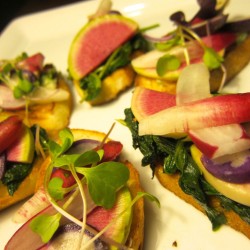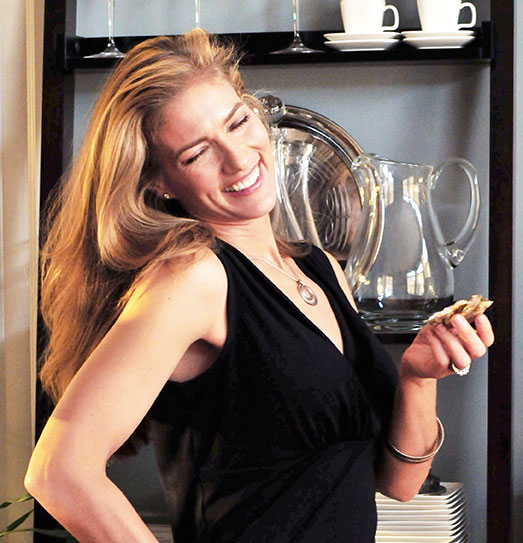Sunday, October 28, 2012

You’ve surely met Raphanus sativas, otherwise known as a radish. A member of the Brassica family (like cabbage, kale and Brussels sprouts), the root is very low in calories but high in fiber, water, vitamin C, potassium, and other good things like sulfuraphane, an isothiocyanate with antioxidant capacity that has anti-cancer properties and does a body good. The leaves are also incredibly nutritious, especially when it comes to iron, calcium, beta-carotene, and yet more vitamin C. Even so, there’s a lot more to this humble little vegetable than perhaps you realize, so read on for a few little known radish facts and to learn why I’m such a fan.
The roots: more than one kind. Depending on where you shop, you may only be familiar with the common red globe radish. However, there are a startling number of varieties ranging from the spherical watermelon (below) to the elongated French above, alongside  the globe radishes). Shape, size, and color vary accordingly and there are also subtle differences in texture, heat, and flavor. There’s a radish to suit every palate, really: some are hot, some are sweet, some are purple, some are pink. Take your pick! A delightful part of my farmers’ markets travels has been finding all kinds of different radish varieties that I’ve never seen at any supermarket, even those focused on produce. You simply can’t find many of these splendid vegetables anywhere but your local farms, and their unique properties make cooking challenging, exciting, and interesting. Also, tasty.
the globe radishes). Shape, size, and color vary accordingly and there are also subtle differences in texture, heat, and flavor. There’s a radish to suit every palate, really: some are hot, some are sweet, some are purple, some are pink. Take your pick! A delightful part of my farmers’ markets travels has been finding all kinds of different radish varieties that I’ve never seen at any supermarket, even those focused on produce. You simply can’t find many of these splendid vegetables anywhere but your local farms, and their unique properties make cooking challenging, exciting, and interesting. Also, tasty.
Don’t “Eat Roots, and Leave!”
The leaves: waste not, want not. A bunch of purple radishes I recently bought came with their gorgeous greens (right); you’ll note the leaves are much larger for this variety than  for the French to match the respective radish root size. Unfortunately, supermarket radishes usually don’t come with their greens still attached. I don’t know why this is, or where the greens go. My guess is they get discarded, as does so much food. This is tragic given the staggering amount of food waste in the world: in the US, for example, about 40% of food is wasted, to the tune of $165B. And, like so much food that is thrown out, radish greens are perfectly edible and delicious. The leaves of the radish plant can be used in salads, braising, or sautéing, like other leafy greens. In fact, the reason I employ radish greens in so many of my dishes is because I often have the roots hanging around for use in salads. So, I’ll often sauté them with EVOO and garlic and use them in a stir fry, soup, omelet, or whatever I’m making. I’ll share a few other fun uses of radish roots and leaves this coming week. (Update: see my French radish crostini here.) Perhaps you’ll get as excited about this vegetable as I am!
for the French to match the respective radish root size. Unfortunately, supermarket radishes usually don’t come with their greens still attached. I don’t know why this is, or where the greens go. My guess is they get discarded, as does so much food. This is tragic given the staggering amount of food waste in the world: in the US, for example, about 40% of food is wasted, to the tune of $165B. And, like so much food that is thrown out, radish greens are perfectly edible and delicious. The leaves of the radish plant can be used in salads, braising, or sautéing, like other leafy greens. In fact, the reason I employ radish greens in so many of my dishes is because I often have the roots hanging around for use in salads. So, I’ll often sauté them with EVOO and garlic and use them in a stir fry, soup, omelet, or whatever I’m making. I’ll share a few other fun uses of radish roots and leaves this coming week. (Update: see my French radish crostini here.) Perhaps you’ll get as excited about this vegetable as I am!
If all of this is a moot point because you’re never before seen radish greens where you live, at least it now makes more sense to you why a number of my recipes include them (e.g., roasted vegetable terrine) rather than, say, spinach. Further, taking a moment to think about food waste and the changes you might make to your own behavior to do your part is always good, too, whether radish-related or not. For cooking, purposes, you can always use whatever leafy green you like in your dishes, I just love being able to use the entire radish plant when I buy it. Makes me happy.
Radishes appear to make Mexicans happy, too: according to Wikipedia, citizens of Oaxaca celebrate the plant in a festival called Noche de los Rábanos (Night of the Radishes). While Americans carve pumpkins into scary faces for display on October 31, Oaxacans sculpt radishes into religious and popular figures and display them in the town square on December 23.
Now that’s a fascinating radish fact.






Several stores in my area have either the pre-cleaned Radishes or a bunch with the leaves still attached. I purchase the ones with the leaves because I think they taste better – but now I will receive an added bonus. Question – Is it okay to eat them by themselves (raw), or do they have to be cooked? Thanks for the information.
Great! Thanks for the comment and question. Indeed they can be eaten raw in salads or whatnot. They aren’t as tasty as other salad greens, in my view, so I often sauté them, but it really depends on the radish variety, really. Enjoy!
I can tell you why radish greens are sometimes hard to find. When I buy radishes with their greens intact, I have to eat them very quickly. The next day the greens are ruining. However, the roots are easy to cut away from the greens. I also don’t have good refrigeration either. That could affect the sale of radishes with greens intact if a lot of people can’t keep them long.
Some things just don’t last long. I cannot buy spinach packed with arugula greens because the arugula decomposes rapidly, leaving me with spinach greens that I also have to throw out. It is best to grow the arugula. We have to know what we can keep and what we have to throw away.
Hi
Nice to see someone getting enthusiastic about the humble radish! But did you know it’s one of the easiest seeds to grow!?
Bulk seeds can be purchased online making it easy to grow our own! But you don’t have to wait for long as within a week you can be enjoying them in your salads!
Although most people use soil I have just started growing my own radishes in my aquaponic system to eat as microgreen shoots!
I want to use my aquaponic system as it means I can grow them without soil keeping the roots clean and healthy, the variety I have is scarlet globe which grows a good sized leaf early on and are naturally quite leggy,
I started to use hydrogen clay balls for a grow medium which will control the development of the radish ball, I will be able to pick the plants from the substrate as apposed to cutting them extending their storage time further!
Delicious in salads and very quick growing! Radish is a great plant to teach children how to germinate as it is soo easy to do!
There are alot of videos on growing micro greens on line most use soil and cut the stems missing out on the actual root!
I don’t have a website or anything to sell but wanted to let you guys know how easy it is to do!
Give it a grow! You never know!